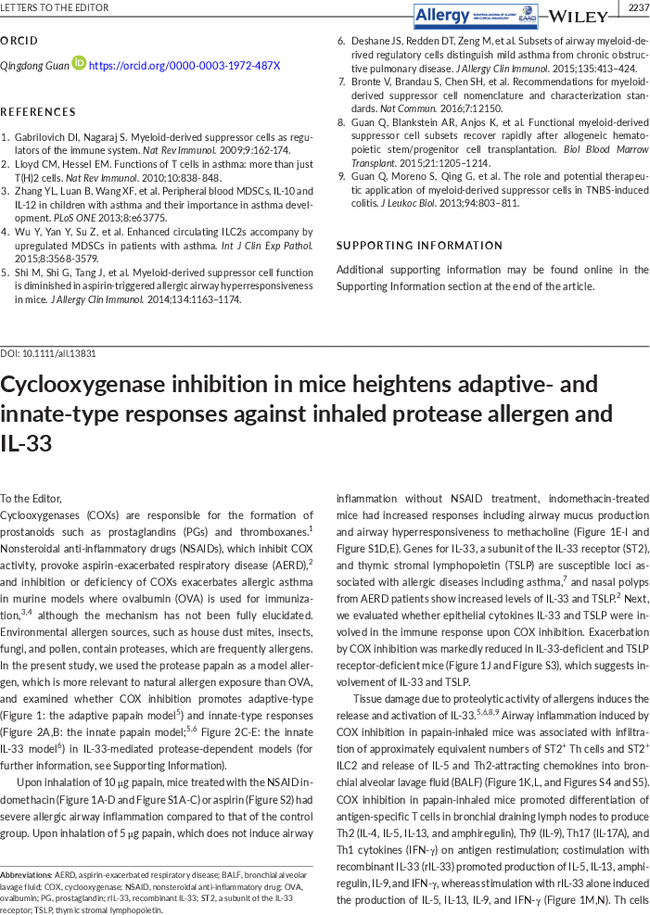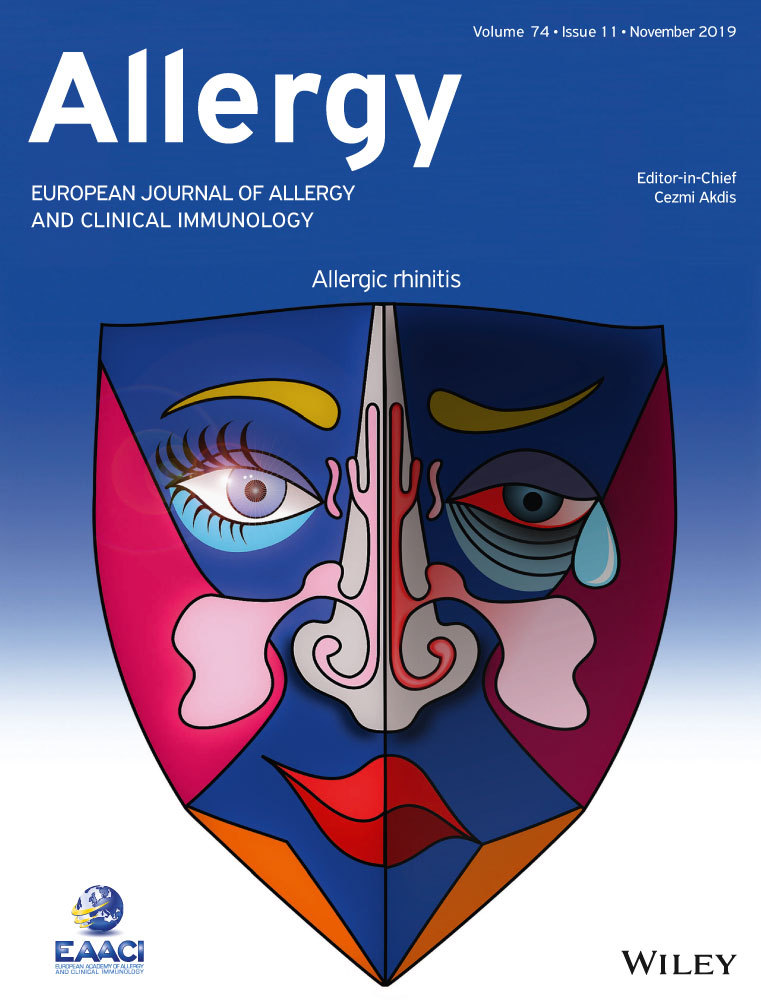Cyclooxygenase inhibition in mice heightens adaptive- and innate-type responses against inhaled protease allergen and IL-33
Natsuko Maruyama
Atopy (Allergy) Research Center, Juntendo University Graduate School of Medicine, Tokyo, Japan
Department of Dermatology and Allergology, Juntendo University Graduate School of Medicine, Tokyo, Japan
Search for more papers by this authorCorresponding Author
Toshiro Takai
Atopy (Allergy) Research Center, Juntendo University Graduate School of Medicine, Tokyo, Japan
Correspondence
Toshiro Takai, Atopy (Allergy) Research Center, Juntendo University School of Medicine, 2-1-1 Hongo, Bunkyo-ku, Tokyo 113-8421, Japan.
Email: [email protected]
Search for more papers by this authorSeiji Kamijo
Atopy (Allergy) Research Center, Juntendo University Graduate School of Medicine, Tokyo, Japan
Search for more papers by this authorPunyada Suchiva
Atopy (Allergy) Research Center, Juntendo University Graduate School of Medicine, Tokyo, Japan
Department of Dermatology and Allergology, Juntendo University Graduate School of Medicine, Tokyo, Japan
Search for more papers by this authorMai Ohba
Department of Biochemistry, Juntendo University Graduate School of Medicine, Tokyo, Japan
Search for more papers by this authorTomohito Takeshige
Department of Respiratory Medicine, Juntendo University Graduate School of Medicine, Tokyo, Japan
Search for more papers by this authorMayu Suzuki
Atopy (Allergy) Research Center, Juntendo University Graduate School of Medicine, Tokyo, Japan
Search for more papers by this authorMutsuko Hara
Atopy (Allergy) Research Center, Juntendo University Graduate School of Medicine, Tokyo, Japan
Search for more papers by this authorKei Matsuno
Department of Respiratory Medicine, Juntendo University Graduate School of Medicine, Tokyo, Japan
Search for more papers by this authorSonoko Harada
Department of Respiratory Medicine, Juntendo University Graduate School of Medicine, Tokyo, Japan
Search for more papers by this authorNorihiro Harada
Department of Respiratory Medicine, Juntendo University Graduate School of Medicine, Tokyo, Japan
Search for more papers by this authorSusumu Nakae
Laboratory of Systems Biology, Center for Experimental Medicine and Systems Biology, The Institute of Medical Science, The University of Tokyo, Tokyo, Japan
Search for more papers by this authorKatsuko Sudo
Pre-clinical Research Center, Tokyo Medical University, Tokyo, Japan
Search for more papers by this authorToshiaki Okuno
Department of Biochemistry, Juntendo University Graduate School of Medicine, Tokyo, Japan
Search for more papers by this authorTakehiko Yokomizo
Department of Biochemistry, Juntendo University Graduate School of Medicine, Tokyo, Japan
Search for more papers by this authorHideoki Ogawa
Department of Dermatology and Allergology, Juntendo University Graduate School of Medicine, Tokyo, Japan
Search for more papers by this authorKo Okumura
Atopy (Allergy) Research Center, Juntendo University Graduate School of Medicine, Tokyo, Japan
Search for more papers by this authorShigaku Ikeda
Atopy (Allergy) Research Center, Juntendo University Graduate School of Medicine, Tokyo, Japan
Department of Dermatology and Allergology, Juntendo University Graduate School of Medicine, Tokyo, Japan
Search for more papers by this authorNatsuko Maruyama
Atopy (Allergy) Research Center, Juntendo University Graduate School of Medicine, Tokyo, Japan
Department of Dermatology and Allergology, Juntendo University Graduate School of Medicine, Tokyo, Japan
Search for more papers by this authorCorresponding Author
Toshiro Takai
Atopy (Allergy) Research Center, Juntendo University Graduate School of Medicine, Tokyo, Japan
Correspondence
Toshiro Takai, Atopy (Allergy) Research Center, Juntendo University School of Medicine, 2-1-1 Hongo, Bunkyo-ku, Tokyo 113-8421, Japan.
Email: [email protected]
Search for more papers by this authorSeiji Kamijo
Atopy (Allergy) Research Center, Juntendo University Graduate School of Medicine, Tokyo, Japan
Search for more papers by this authorPunyada Suchiva
Atopy (Allergy) Research Center, Juntendo University Graduate School of Medicine, Tokyo, Japan
Department of Dermatology and Allergology, Juntendo University Graduate School of Medicine, Tokyo, Japan
Search for more papers by this authorMai Ohba
Department of Biochemistry, Juntendo University Graduate School of Medicine, Tokyo, Japan
Search for more papers by this authorTomohito Takeshige
Department of Respiratory Medicine, Juntendo University Graduate School of Medicine, Tokyo, Japan
Search for more papers by this authorMayu Suzuki
Atopy (Allergy) Research Center, Juntendo University Graduate School of Medicine, Tokyo, Japan
Search for more papers by this authorMutsuko Hara
Atopy (Allergy) Research Center, Juntendo University Graduate School of Medicine, Tokyo, Japan
Search for more papers by this authorKei Matsuno
Department of Respiratory Medicine, Juntendo University Graduate School of Medicine, Tokyo, Japan
Search for more papers by this authorSonoko Harada
Department of Respiratory Medicine, Juntendo University Graduate School of Medicine, Tokyo, Japan
Search for more papers by this authorNorihiro Harada
Department of Respiratory Medicine, Juntendo University Graduate School of Medicine, Tokyo, Japan
Search for more papers by this authorSusumu Nakae
Laboratory of Systems Biology, Center for Experimental Medicine and Systems Biology, The Institute of Medical Science, The University of Tokyo, Tokyo, Japan
Search for more papers by this authorKatsuko Sudo
Pre-clinical Research Center, Tokyo Medical University, Tokyo, Japan
Search for more papers by this authorToshiaki Okuno
Department of Biochemistry, Juntendo University Graduate School of Medicine, Tokyo, Japan
Search for more papers by this authorTakehiko Yokomizo
Department of Biochemistry, Juntendo University Graduate School of Medicine, Tokyo, Japan
Search for more papers by this authorHideoki Ogawa
Department of Dermatology and Allergology, Juntendo University Graduate School of Medicine, Tokyo, Japan
Search for more papers by this authorKo Okumura
Atopy (Allergy) Research Center, Juntendo University Graduate School of Medicine, Tokyo, Japan
Search for more papers by this authorShigaku Ikeda
Atopy (Allergy) Research Center, Juntendo University Graduate School of Medicine, Tokyo, Japan
Department of Dermatology and Allergology, Juntendo University Graduate School of Medicine, Tokyo, Japan
Search for more papers by this author
Supporting Information
| Filename | Description |
|---|---|
| all13831-sup-0001-Supinfo.pdfPDF document, 1,018 KB |
Please note: The publisher is not responsible for the content or functionality of any supporting information supplied by the authors. Any queries (other than missing content) should be directed to the corresponding author for the article.
REFERENCES
- 1Samuchiwal SK, Boyce JA. Role of lipid mediators and control of lymphocyte responses in type 2 immunopathology. J Allergy Clin Immunol. 2018; 141: 1182-1190.
- 2Laidlaw TM, Boyce JA. Aspirin-exacerbated respiratory disease–new prime suspects. N Engl J Med. 2016; 374: 484-488.
- 3Peebles RS Jr, Hashimoto K, Morrow JD, et al. Selective cyclooxygenase-1 and -2 inhibitors each increase allergic inflammation and airway hyperresponsiveness in mice. Am J Respir Crit Care Med. 2002; 165: 1154-1160.
- 4Gavett SH, Madison SL, Chulada PC, et al. Allergic lung responses are increased in prostaglandin H synthase-deficient mice. J Clin Invest. 1999; 104: 721-732.
- 5Kamijo S, Takeda H, Tokura T, et al. IL-33-mediated innate response and adaptive immune cells contribute to maximum responses of protease allergen-induced allergic airway inflammation. J Immunol. 2013; 190: 4489-4499.
- 6Oboki K, Ohno T, Kajiwara N, et al. IL-33 is a crucial amplifier of innate rather than acquired immunity. Proc Natl Acad Sci USA. 2010; 107: 18581-18586.
- 7Tamari M, Tanaka S, Hirota T. Genome-wide association studies of allergic diseases. Allergol Int. 2013; 62: 21-28.
- 8Halim TY, Steer CA, Matha L, et al. Group 2 innate lymphoid cells are critical for the initiation of adaptive T helper 2 cell-mediated allergic lung inflammation. Immunity. 2014; 40: 425-435.
- 9Cayrol C, Duval A, Schmitt P, et al. Environmental allergens induce allergic inflammation through proteolytic maturation of IL-33. Nat Immunol. 2018; 19: 375-385.
- 10Nishioka I, Takai T, Maruyama N, et al. Airway inflammation after epicutaneous sensitization of mice requires protease activity of low-dose allergen inhalation. J Allergy Clin Immunol. 2018; 141: 2271-2273.




